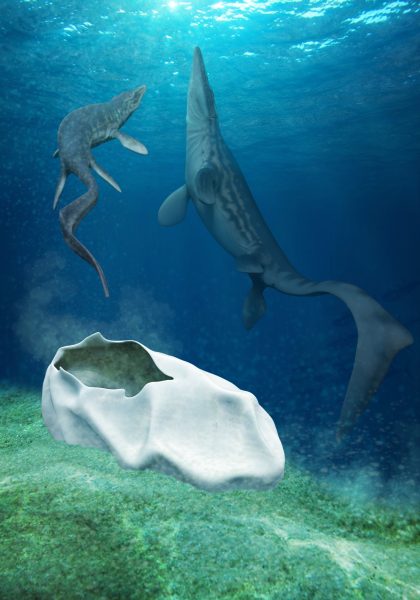Monster Egg
November 12, 2020

In 2011, Chilean scientists discovered a mysterious fossil in Antarctica that looked like a deflated football. For nearly a decade, the specimen sat in the collections of Chile’s National Museum of Natural History, with scientists identifying it only by its sci-fi movie-inspired nickname — “The Thing.”
An analysis led by Lucas Legendre, a Jackson School of Geosciences postdoctoral researcher, has found that the fossil is a giant, soft-shell egg from about 66 million years ago. Measuring in at about a foot long, the egg is the largest soft-shell egg ever discovered and the second-largest egg of any known animal. The specimen is the first fossil egg found in Antarctica and pushes the limits of how big scientists thought soft-shell eggs could grow. Aside from its astounding size, the fossil is significant because scientists think it was laid by an extinct, giant marine reptile, such as a mosasaur. The discovery challenges the prevailing thought that such creatures did not lay eggs.
“It is from an animal the size of a large dinosaur, but it is completely unlike a dinosaur egg,” said Legendre.
A study describing the fossil egg was published in Nature on June 17, 2020. Co-author David Rubilar-Rogers of Chile’s National Museum of Natural History was one of the scientists who discovered the fossil in 2011. He showed it to every geologist who came to the museum, hoping somebody had an idea, but he didn’t find anyone until Julia Clarke, a professor in the Department of Geological Sciences, visited in 2018.
“I showed it to her, and after a few minutes, Julia told me it could be a deflated egg!” Rubilar-Rogers said. Using a suite of microscopes to study samples, Legendre found several layers of membrane that confirmed that the fossil was indeed an egg. Since the egg is hatched and has no skeleton, he had to use other means to zero in on the type of reptile that laid it.
By comparing the size of 259 living reptiles to the size of their eggs, Legendre came up with an estimate that puts the ancient egg layer at more than 20 feet long, not counting a tail. In both size and living reptile relations, an ancient marine reptile fits the bill.
Adding to that evidence, the rock formation where the egg was discovered also hosts skeletons from baby mosasaurs and plesiosaurs, along with adult specimens.
The paper does not discuss how the ancient reptile might have laid the eggs. But the researchers have two competing ideas.
One involves the egg hatching in the open water, which is how some species of sea snakes give birth. The other involves the reptile depositing the eggs on a beach.
The study’s other co-authors are Clarke, Jackson School graduate students Sarah Davis and Grace Musser, and Rodrigo Otero and Alexander Vargas of the University of Chile.
Back to the Newsletter